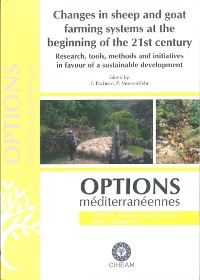| Article précédent | p. 241-243 | Article suivant |
Nutraceutical properties of goat milk: in silico analysis of the casein sequences
Milk proteins are of particular interest from the point of view of human nutrition, because they carry peptides with particular biological activities, and also causing symptoms of allergies. The identification of protein allergens is an important tool for human food safety. An in silico approach was followed in order to find biopeptides and epitopes already identified in the bovine species within the goat casein sequences and their genetic variants. Out of biopeptides shared with bovine milk, 9 show opioide activity, 5 are mineral carriers, 23 show hypotensive activity, 3 are antithrombotic and 6 are immunomodulators. All the goat genetic variants were considered and differences in the aminoacid sequence of the biopeptides were found in 5 of them. The epitope analysis was carried out for ?s1-casein. With the exception of the 5th major and the 1st minor epitope, several differences were found both between species and among goat genetic variants.
Les lactoprotéines contiennent des peptides présentant des actions biologiques spécifiques et causant aussi des symptômes d'allergie. L'identification des protéines qui causent des allergies est très importante pour la nutrition et la santé humaines. Une analyse in silico a été conduite pour rechercher la présence de peptides et d'épitopes déjà identifiés chez l'espèce bovine, en utilisant les séquences caséiniques caprines et leurs variants génétiques. Parmi les biopeptides en commun avec le lait de vache, 9 montrent une activité opioïde, 5 sont des transporteurs minéraux, 23 ont un rôle hypotensif, 3 ont un rôle anti-thrombose et 6 sont immunomodulateurs. Des différences ont été trouvées dans les séquences des aminoacides de 5 variants génétiques. L'analyse des épitopes a été conduite sur la ?s1-caséine. Sauf pour le 5ème épitope majeur et le 1er épitope mineur, plusieurs différences ont été remarquées entre l'espèce bovine et caprine et parmi les variants génétiques de la chèvre.
- [ Afficher ]
- [ Télécharger ]
- [ Exporter la citation ]
Vous pouvez télécharger la citation au format :
- [ Imprimer ]
-
Mots-clés
CASEINE, LAIT DE CHEVRE, NUTRITION HUMAINE, PEPTIDE, POLYMORPHISME GENETIQUECiter cet article
Chessa S., Chiatti F., Rignanese D., Ceriotti G., Caroli A., Pagnacco G. Nutraceutical properties of goat milk: in silico analysis of the casein sequences. In : Pacheco F. (ed.), Morand-Fehr P. (ed.). Changes in sheep and goat farming systems at the beginning of the 21st century : research, tools, methods and initiatives in favour of a sustainable development . Zaragoza : CIHEAM / DRAP-Norte / FAO, 2009. p. 241-243. (Options Méditerranéennes : Série A. Séminaires Méditerranéens; n. 91). Proceedings of the Seminar of the Subnetwork on Production Systems of the FAO-CIHEAM Network for Research and Development in Sheep and Goats, 2007/11/15-17, Ponte de Lima (Portugal). http://om.ciheam.org/om/pdf/a91/00801153.pdf



